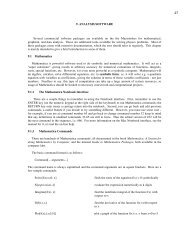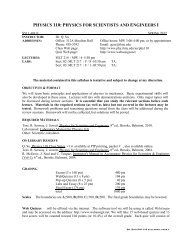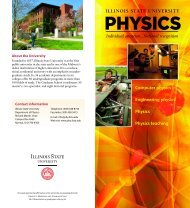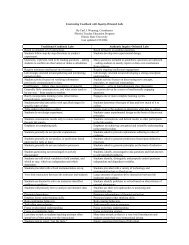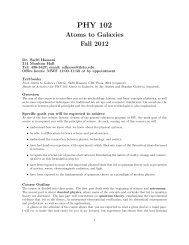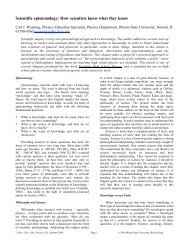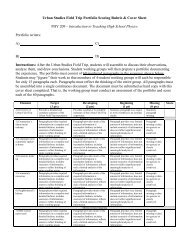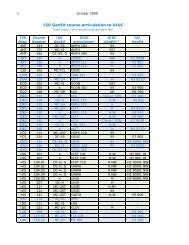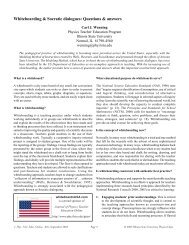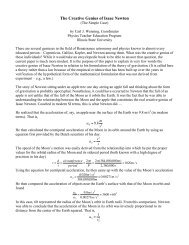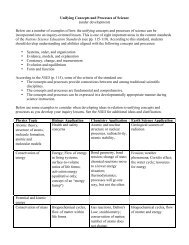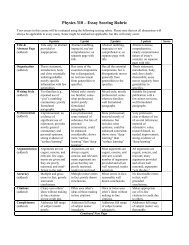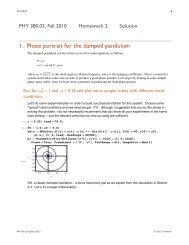Chi-Square Test for Goodness of Fit
Chi-Square Test for Goodness of Fit
Chi-Square Test for Goodness of Fit
You also want an ePaper? Increase the reach of your titles
YUMPU automatically turns print PDFs into web optimized ePapers that Google loves.
<strong>Chi</strong>-<strong>Square</strong> <strong>Test</strong> <strong>for</strong> <strong>Goodness</strong> <strong>of</strong> <strong>Fit</strong><br />
(after Applied Statistics by Hinkle/Wiersma/Jurs)<br />
Scientists will <strong>of</strong>ten use the <strong>Chi</strong>-square ( χ<br />
€<br />
2 ) test to determine the goodness <strong>of</strong> fit between theoretical<br />
and experimental data. In this test, we compare observed values with theoretical or expected values.<br />
Observed values are those that the researcher obtains empirically through direct observation; theoretical<br />
or expected values are developed on the basis <strong>of</strong> some hypothesis. For example, in 200 flips <strong>of</strong> a coin, one<br />
would expect 100 heads and 100 tails. But what if 92 heads and 108 tails are observed? Would we reject<br />
the hypothesis that the coin is fair? Or would we attribute the difference between observed and expected<br />
frequencies to random fluctuation?<br />
Consider another example. Suppose we hypothesize that we have an unbiased six-sided die. To test<br />
this hypothesis, we roll the die 300 times and observe the frequency <strong>of</strong> occurrence <strong>of</strong> each <strong>of</strong> the faces.<br />
Because we hypothesized that the die is unbiased, we expect that the number on each face will occur 50<br />
times. However, suppose we observe frequencies <strong>of</strong> occurrence as follows:<br />
Face value Occurrence<br />
1 42<br />
2 55<br />
3 38<br />
4 57<br />
5 64<br />
6 44<br />
Again, what would we conclude? Is the die biased, or do we attribute the difference to random<br />
fluctuation?<br />
Consider a third example. The president <strong>of</strong> a major university hypothesizes that at least 90 percent <strong>of</strong><br />
the teaching and research faculty will favor a new university policy on consulting with private and public<br />
agencies within the state. Thus, <strong>for</strong> a random sample <strong>of</strong> 200 faculty members, the president would expect<br />
0.90 x 200 = 180 to favor the new policy and 0.10 x 200 = 20 to oppose it. Suppose, however, <strong>for</strong> this<br />
sample, 168 faculty members favor the new policy and 32 oppose it. Is the difference between observed<br />
and expected frequencies sufficient to reject the president's hypothesis that 90 percent would favor the<br />
policy? Or would the differences be attributed to chance fluctuation?<br />
Lastly, consider an experimental result where, <strong>for</strong> given independent values <strong>of</strong> “X,” the following<br />
theoretical (expected) and experimental (observed) dependent values <strong>of</strong> Y were found:<br />
X Ytheoretical Yexperimental<br />
3.45 11.90 11.37<br />
4.12 16.97 17.02<br />
4.73 22.37 23.78<br />
5.23 27.35 26.13<br />
6.01 36.12 35.96<br />
6.82 46.51 45.22<br />
7.26 52.71 53.10<br />
In each <strong>of</strong> these examples, the test statistic <strong>for</strong> comparing observed and expected frequencies is χ<br />
€<br />
2 ,<br />
defined as follows:<br />
χ 2 (O − E)<br />
=<br />
2<br />
k<br />
∑ i=1 E<br />
where<br />
€
The calculations <strong>of</strong><br />
€<br />
O = observed value<br />
E = expected value<br />
k = number <strong>of</strong> categories, groupings, or possible outcomes<br />
χ 2 <strong>for</strong> each <strong>of</strong> the three examples, using the above <strong>for</strong>mula, are found in Tables 1-4.<br />
TABLE 1. Calculation <strong>of</strong> χ 2 <strong>for</strong> the Coin-Toss Example<br />
Face O E O-E (O-E)<br />
€<br />
2 (O-E) 2 /E<br />
Heads 92 100 -8 64 .64<br />
Tails<br />
Totals<br />
108<br />
200<br />
100<br />
200<br />
+8<br />
0<br />
64<br />
--<br />
.64<br />
1.28 =<br />
TABLE 2. Calculation <strong>of</strong> χ 2 <strong>for</strong> the Die Example<br />
Face Value O E O-E (O-E)<br />
€<br />
2 (O-E) 2 /E<br />
1 42 50 -8 64 1.28<br />
2<br />
3<br />
55<br />
38<br />
50<br />
50<br />
5<br />
-12<br />
25<br />
144<br />
.50<br />
2.88<br />
4 57 50 7 49 .98<br />
5 64 50 14 196 3.92<br />
6 44 50 -6 36 .72<br />
Totals 300 300 0 --<br />
10.28=<br />
TABLE 3. Calculation <strong>of</strong> χ 2 <strong>for</strong> the Consulting-Policy Example<br />
Disposition O E O-E (O-E)<br />
€<br />
2 (O-E) 2 /E<br />
Favor 168 180 -12 144 .80<br />
Oppose<br />
Totals<br />
32<br />
200<br />
20<br />
200<br />
+12<br />
0<br />
144<br />
--<br />
7.20<br />
8.00=<br />
TABLE 4. Calculation <strong>of</strong> χ 2 <strong>for</strong> the Experiment Example<br />
X O E O-E (O-E)<br />
€<br />
2 (O-E) 2 /E<br />
3.45 11.37 11.90 -.53 .28 .02<br />
4.12<br />
4.73<br />
17.02<br />
23.78<br />
16.97<br />
22.37<br />
.05<br />
1.41<br />
.02<br />
1.99<br />
.00<br />
.09<br />
5.23 26.13 27.35 -1.22 1.49 .05<br />
6.01 35.96 36.12 -.16 .03 .00<br />
6.82 45.22 46.51 -1.29 1.66 .04<br />
7.26 53.10 52.71 .39 .15 .00<br />
Totals 212.58 213.93 -1.35 5.62<br />
0.20 =<br />
There is a family <strong>of</strong> χ<br />
€<br />
€<br />
2 distributions, each a function <strong>of</strong> the degrees <strong>of</strong> freedom associated with the<br />
number <strong>of</strong> categories in the sample data. Only a single degree <strong>of</strong> freedom (df) value is required to identify<br />
the specific χ<br />
€<br />
2 distribution. Notice that all values <strong>of</strong> χ<br />
€<br />
2 are positive, ranging from zero to infinity.<br />
Consider the degrees <strong>of</strong> freedom <strong>for</strong> each <strong>of</strong> the above examples. In the coin example, note that the<br />
expected frequencies in each <strong>of</strong> the two categories (heads or tails) are not independent. To obtain the<br />
expected frequency <strong>of</strong> tails (100), we need only to subtract the expected frequency <strong>of</strong> heads (100) from<br />
the total frequency (200), or 200 - 100 = 100. Similarly, <strong>for</strong> the example <strong>of</strong> the new consulting policy, the<br />
expected number <strong>of</strong> faculty members who oppose it (20) can be found by subtracting the expected<br />
number who support it (180) from the total number in the sample (200), or 200 – 180 = 20. Thus, given<br />
€<br />
€<br />
€<br />
χ 2<br />
χ 2<br />
χ 2<br />
χ 2
the expected frequency in one <strong>of</strong> the categories, the expected frequency in the other is readily determined.<br />
In other words, only the expected frequency in one <strong>of</strong> the two categories is free to vary; that is, there is<br />
only 1 degree <strong>of</strong> freedom associated with these examples.<br />
For the die example, there are six possible categories <strong>of</strong> outcomes: the occurrence <strong>of</strong> the six faces.<br />
Under the assumption that the die is fair, we would expect that the frequency <strong>of</strong> occurrence <strong>of</strong> each <strong>of</strong> the<br />
six faces <strong>of</strong> the die would be 50. Note again that the expected frequencies in each <strong>of</strong> these categories are<br />
not independent. Once the expected frequency <strong>for</strong> five <strong>of</strong> the categories is known, the expected frequency<br />
<strong>of</strong> the sixth category is uniquely determined, since the total frequency equals 300. Thus, only the expected<br />
frequencies in five <strong>of</strong> the six categories are free to vary; there are only 5 degrees <strong>of</strong> freedom associated<br />
with this example.<br />
In the last example dealing with the data from the experiment, the cross-tabulation table has 2<br />
columns and 7 rows. The degrees <strong>of</strong> freedom <strong>for</strong> such tables is (# rows – 1)(# columns – 1) = (6)(1) = 6<br />
The Critical Values <strong>for</strong> the χ<br />
€<br />
2 Distribution<br />
The use <strong>of</strong> the χ<br />
€<br />
2 distribution in hypothesis testing is analogous to the use <strong>of</strong> the t and F distributions.<br />
A null hypothesis is stated, a test statistic is computed, the observed value <strong>of</strong> the test statistic is compared<br />
to the critical value, and a decision is made whether or not to reject the null hypothesis. For the coin<br />
example, the null hypothesis is that the frequency <strong>of</strong> heads is equal to the frequency <strong>of</strong> tails. For the die<br />
example, the null hypothesis is that the frequency <strong>of</strong> occurrence <strong>of</strong> each <strong>of</strong> the six faces is the same. In<br />
general, it is not a requirement <strong>for</strong> the categories to have equal expected frequencies. For instance, in the<br />
example <strong>of</strong> the new consulting policy, the null hypothesis is that 90 percent <strong>of</strong> the faculty will support the<br />
new policy and 10 percent will not.<br />
The critical values <strong>of</strong> χ<br />
€<br />
2 <strong>for</strong> 1 through 30 degrees <strong>of</strong> freedom are found in Table 5. Three different<br />
percentile points in each distribution are given – α = .10, α = .05, and α = .01. (e.g., chances <strong>of</strong> 10%, 5%,<br />
and 1% respectively <strong>of</strong> rejecting the null hypothesis when it should be retained). For the coin and<br />
consulting-policy examples, the critical values <strong>of</strong> χ<br />
€<br />
2 <strong>for</strong> 1 degree <strong>of</strong> freedom, with α = .05 and α = .01,<br />
are 3.841 and 6.635, respectively. For the die example, the corresponding critical values <strong>of</strong> χ<br />
€<br />
2 <strong>for</strong> 5<br />
degrees <strong>of</strong> freedom are 11.070 and 15.086. Although Table 5 is sufficient <strong>for</strong> many research settings in<br />
the sciences, there are some situations in which the degrees <strong>of</strong> freedom associated with a χ<br />
€<br />
2 test are<br />
greater than 30. These situations are not addressed here.<br />
Now that we have seen the table <strong>of</strong> critical values <strong>for</strong> the χ<br />
€<br />
2 distribution, we can complete the<br />
examples. For the coin example, the null hypothesis is that the frequency <strong>of</strong> heads equals the frequency <strong>of</strong><br />
tails. As we mentioned, because there are only two categories, once the expected value <strong>of</strong> the first<br />
category is determined, the second is uniquely determined. Thus, there is only 1 degree <strong>of</strong> freedom<br />
associated with this example. Assuming that the α = .05 level <strong>of</strong> significance is used in testing this null<br />
hypothesis, the critical value <strong>of</strong> χ<br />
€<br />
2 2<br />
( χCV ) is 3.841 (see Table 5). Notice that, in Table 1, the calculated<br />
value <strong>of</strong> χ<br />
€<br />
€<br />
2 is 1.28. Because the calculated value does not exceed the critical value, the null hypothesis<br />
(the coin is fair) is not rejected; the differences between observed and expected frequencies are<br />
attributable to chance fluctuation. That is, when the calculated value <strong>of</strong> χ<br />
€<br />
2 exceeds the critical value, the<br />
data support the belief that a significant difference exists between expected and actual values.<br />
For the example <strong>of</strong> the new consulting policy, the null hypothesis is that 90 percent <strong>of</strong> the faculty<br />
would support it and 10 percent would not. Again, because there are only two categories, there is 1 degree<br />
2<br />
<strong>of</strong> freedom associated with the test <strong>of</strong> this hypothesis. Thus, assuming α = .05, the χCV is 3.841. From<br />
Table 3, we see that the calculated value <strong>of</strong> χ<br />
€<br />
€<br />
2 is 8.00; there<strong>for</strong>e, the null hypothesis (that there is no<br />
difference) is rejected. The conclusion is that the percentage <strong>of</strong> faculty supporting the new consulting<br />
policy is not 90.
€<br />
For the die example, the null hypothesis is that the frequency <strong>of</strong> occurrence <strong>of</strong> each <strong>of</strong> the six faces is<br />
the same. With six categories, there are 5 degrees <strong>of</strong> freedom associated with the test <strong>of</strong> this hypothesis;<br />
2<br />
the χCV <strong>for</strong> α = .05 is 11.070. Using the data from Table 2, χ<br />
€<br />
2 = 10.28. Because this calculated value is<br />
less than the critical value, the null hypothesis is retained. The conclusion is that the differences between<br />
the observed and expected frequencies in each <strong>of</strong> the six categories are attributable to chance fluctuation.<br />
For the example with the experiment, the null hypothesis is that there is no difference between<br />
theoretical and experimental results. With seven data pairs there are 6 degrees <strong>of</strong> freedom associated with<br />
2<br />
the test <strong>of</strong> this hypothesis; the χCV <strong>for</strong> α = .05 is 12.592. Because this calculated value <strong>of</strong> χ<br />
€<br />
€<br />
2 (0.20) is<br />
less than the critical value (12.592), the null hypothesis is retained. The conclusion is that the differences<br />
between the observed and expected values in each <strong>of</strong> the seven data pairs are attributable to chance<br />
fluctuation. The experimental results are there<strong>for</strong>e consistent with the theoretical results to with a 95%<br />
chance <strong>of</strong> probability.<br />
TABLE 5. CRITICAL χ 2 VALUES FOR UP TO 30 DEGREES OF FREEDOM<br />
€<br />
df<br />
1<br />
2<br />
3<br />
4<br />
5<br />
6<br />
7<br />
8<br />
9<br />
10<br />
11<br />
12<br />
13<br />
14<br />
15<br />
16<br />
17<br />
18<br />
19<br />
20<br />
21<br />
22<br />
23<br />
24<br />
25<br />
26<br />
27<br />
28<br />
29<br />
30<br />
α = .10<br />
2.706<br />
4.605<br />
6.251<br />
7.779<br />
9.236<br />
10.645<br />
12.017<br />
13.362<br />
14.684<br />
15.987<br />
17.275<br />
18.549<br />
19.812<br />
21.064<br />
22.307<br />
23.542<br />
24.769<br />
25.989<br />
27.204<br />
28.412<br />
29.615<br />
30.813<br />
32.007<br />
33.196<br />
34.382<br />
35.563<br />
36.741<br />
37.916<br />
39.087<br />
40.256<br />
α = .05<br />
3.841<br />
5.991<br />
7.815<br />
9.488<br />
11.070<br />
12.592<br />
14.067<br />
15.507<br />
16.919<br />
18.307<br />
19.675<br />
21.026<br />
22.362<br />
23.685<br />
24.996<br />
26.296<br />
27.587<br />
28.869<br />
30.144<br />
31.410<br />
32.671<br />
33.924<br />
35.172<br />
36.415<br />
37.652<br />
38.885<br />
40.113<br />
41.337<br />
42.557<br />
43.773<br />
α = .01<br />
6.635<br />
9.210<br />
11.345<br />
13.277<br />
15.086<br />
16.812<br />
18.475<br />
20.090<br />
21.666<br />
23.209<br />
24.725<br />
26.217<br />
27.688<br />
29.141<br />
30.578<br />
32.000<br />
33.409<br />
34.805<br />
36.191<br />
37.566<br />
38.932<br />
40.289<br />
41.638<br />
42.980<br />
44.314<br />
45.642<br />
46.963<br />
43.278<br />
49.558<br />
50.892



